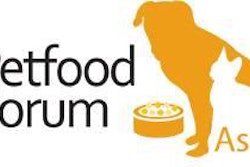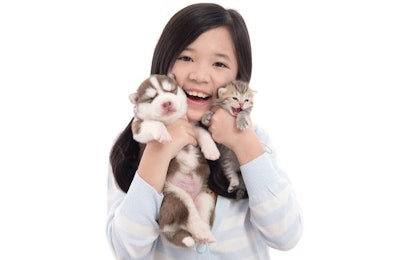
China’s economy has shown steady growth over the last decade, from a GDP (gross domestic product) per capita of US$1,498 in 2004 to US$7,594 in 2014. The GDP annual growth rate over the last several years has hovered around 7.5%, with occasional jumps even higher—reaching just over 10% in 2010, according to the World Bank. Unsurprisingly, then, the annual per capita disposable income of urban households in China has also grown, from CNY15,781 (US$2,479) in 2008 to CNY28,844 (US$4,531) in 2014, according to Statista data.
With a total estimated country population of more than 1.4 billion in 2015, that’s a lot of value—and a lot of potential for the pet food market, as China’s urban populations become more interested in both owning and purchasing products for pets. According to the National Bureau of Statistics of China (NBS China) and GfK, most people who have pet dogs or cats in China are elderly. Approximately 61% of the 65+ age group live with a pet, compared to the national average of 44%. Only the 25 to 29 age group achieves similar levels of pet ownership. In total, China is third in the world as far as dog ownership is concerned: there are 27.4 million pet dogs in China, behind only the US (55.3 million) and Brazil (35.7 million). The country is second in global cat ownership, with 58.1 million cats reported, behind only the US, which has 80.6 million pet cats (see Figure 1).
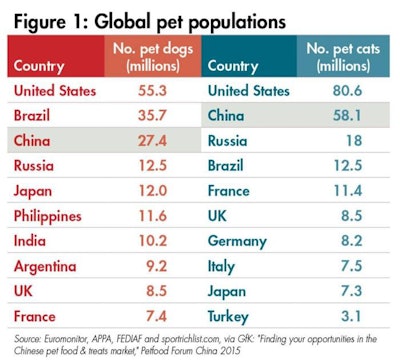
China is the third top country in dog owners and the second in cat owners, suggesting significant market opportunities for global pet food manufacturers.
What do these numbers mean for the current pet food landscape in China? Pet food is definitely a growth market; while China isn’t quite at the very bottom in terms of average monthly spending on dog food per dog, it’s nowhere near the top, according to Euromonitor, Pet Food Manufacturers Association (PFMA) and American Pet Products Manufacturers Association (APPMA) data. At US$0.98 spent per dog, China beats out the bottom five (Ukraine, Egypt, India, the Philippines and Vietnam—at the very bottom, Vietnam dog owners spend just US$0.06 on food per month per dog) but also doesn’t touch the top five (Norway, Switzerland, Australia, Sweden and Austria—at number one, Norway pet owners spend an average of US$53.22 on food per dog each month).
That’s not to say that the current market isn’t significant. According to GfK data, China’s pet food market is worth roughly CNY8.583 billion (US$1.37 billion) in 2015, up 12.3% from 2014, and will be worth an estimated CNY9.743 billion (US$1.53 billion) in 2016, growing 13.5% (see Figure 2).
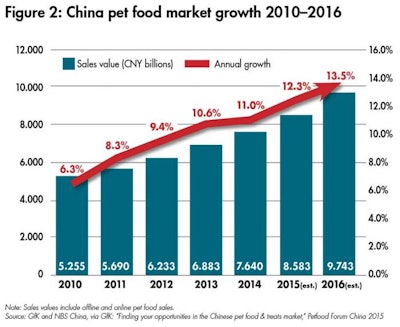
China’s pet food market continues to grow steadily, and is expected to reach CNY9.743 billion (US$1.53 billion) in 2016.
China’s current pet food market is also multifaceted, with online pet food purchasing increasing in value each year—holding an estimated 38% of the total market share in 2015, and an expectation of growing to 43% in 2016, according to GfK. Cat food purchasing in particular is more significant online than offline, holding one-third of the total online China pet food market, while claiming one-quarter of offline purchases.
In terms of what kind of pet food China’s pet owners are purchasing, data collected in Shanghai and Beijing—two of China’s most populous urban cities—show that the vast majority of owners who specified a breed size said they own “small” pets. This, according to GfK, correlates with the higher proportion of “small” breed pet food purchases China’s pet owners make. The response also makes sense, given the significant portion of older people who say they own pets in China, as well as the general expectation of an urban landscape leading to the ownership of smaller pets, better suited for apartment and small space living arrangements.
Treats and specialty pet food, ever-growing trends in more developed pet food markets, have a place in China, as well—mostly as potential growth areas for manufacturers looking at China as a possible expansion route. According to GfK, cat owners in Shanghai and Beijing reported that they exclusively purchased cat food, with no snacks or treats whatsoever. Further, among dog owners, only 11% of food purchases were snacks or treats. Of the dog owners who did buy treats, and bought them offline, the vast majority (81.8%) purchased chewables/meat. Another 8.9% purchased soft treats, and another 7.4% said they purchased crunchy/crispy treats for their dogs.
Natural pet food, a long-standing growth trend in developed markets, is a small but rapidly growing segment of China’s pet food climate. Currently, according to GfK data, 94% of cat food and 81% of dog food purchased in China is non-natural (see Figure 3). However, natural cat food purchases experienced 199.8% growth in 2015, and natural dog food saw 74.4% growth. Compare that to non-natural pet food growth, which saw 18.2% growth in the cat food market and a 3.8% decline in the dog food market.
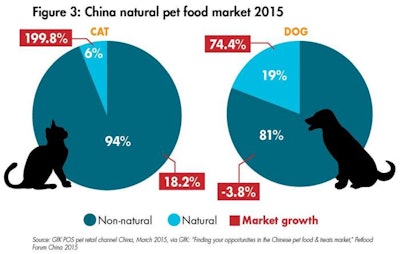
The natural pet food market in China is small but growing exponentially, especially when compared to the non-natural market.
Grain-free, a segment of premium pet food that has seen significant growth in developed markets, makes up only 1% of the total China pet food market. However, the trend is currently growing at 379% year-over-year, according to GfK.
Overall, China’s pet food market is still well in the developing stages, at all levels. But that means plenty of growth potential, particularly with the strong online pet food purchasing segment, for global manufacturers looking to expand into Asia.
Videos: New product development at Petfood Forum China




